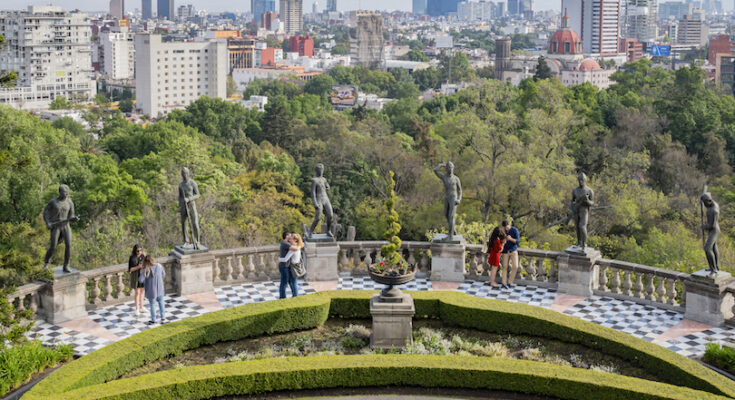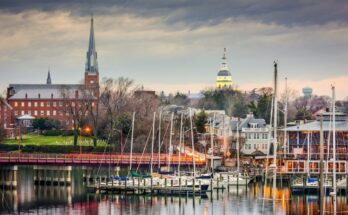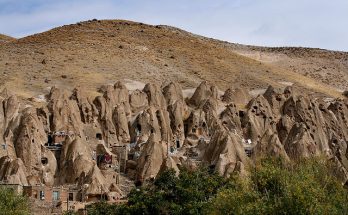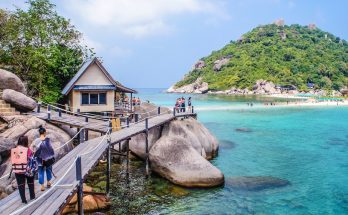With an estimated 20 million people living in the region, Mexico City is one of the world’s largest cities. The origins of this huge city date back to 1325, when the Aztec capital city of Tenochtitlan was founded.
It was later destroyed in 1521 by Spanish conqueror Hernan Cortes. On its ruins a new city was founded which served as the capital of the Vice-royalty of New Spain and later as the capital of Mexico.
The city provides a chance to learn about the Aztecs, one of the world’s great early civilizations, as well as their Spanish conquerors. Many colonial buildings still stand among those of more modern architectural styles.
One of the most interesting things to do in Mexico City is to see the works of Frida Kahlo and her husband Diego Rivera, one of the world’s greatest muralists. Among the top tourist attractions in Mexico City are numerous renowned museums and art galleries with impeccable architectural designs to catch the eye and interest.
You don’t have to go far in Mexico City when you find your appetite rearing. Grab a fresh bite of authentic local cuisine of chapulines, chilaquiles, and tacos al pastor at one of the street vendors dotted around the city to fuel your adventures!
27. Museo Mural Diego Rivera
In Downtown Mexico City near the Palacio de Bellas Artes and Museo Franz Mayer, the Museo Mural Diego Rivera is a museum that features exceptional artwork. One such piece is the Sueño de una tarde dominical en la Alameda Central, which translates to “Dream of a Sunday Afternoon in the Alameda Central” by Diego Rivera. This mural specifically imagines colonial-time figures who once walked Mexico City, including Francisco Madero and Benito Juárez.
Diego Rivera is a memorable artist and Mexican painter who actively created artwork for half a century. He established large frescoes that imparted a significant role in the mural movement in Mexico and internationally. This movement aimed to bring art to the masses on public walls to experience the vibrancy, culture, and craft of these masterful works.
26. Angel de la Independencia

More commonly known as El Ángel, the Ángel de la Independencia is the Monumento a la Independencia. The iconic landmark in downtown Mexico City is situated on a roundabout on the high-traffic road of Paseo de la Reforma near the Embassy of the United States of America.
The Ángel de la Independencia is a tribute and symbol of Mexico’s victory in the War of Independence from Spain. A bronze statue of the Greek goddess of victory, Nike, tops the column monument. The structure was constructed by architect Antonio Rivas Mercado, widely known for building the Municipal Palace in Tlalpan.
The architect’s home has been transformed into a museum, the Casa Rivas Mercado in Mexico City, that displays Mercado’s outstanding works.
25. Mercado Roma

An eclectic stop in Mexico City, Mercado Roma is a public market that features gourmet and cultural foods.
In the hipster neighborhood of La Roma, near the Universidad de Londres Plantel San Luis Potosí, the market encapsulates the beauty and flavor of Mexican culinary traditional foods. Throughout Mercado Roma are numerous vendors selling produce and delicacies in a contemporary-oriented space.
The upper levels of the market have an open terraced area to eat and relax in and a bar and restaurants to grab drinks and food at. The market highlights quality food with a traditional market twist. One such space at the market displays a garden wall where restaurants source fresh ingredients for flavorful meals.
Visiting Mercado Roma is an artisanal food experience that welcomes hungry locals and tourists to Mexico City with open arms.
24. Coyoacan

One of Mexico City’s oldest neighborhoods, Coyoacan, is more widely known for being the area where Frida Kahlo lived. The neighborhood is south of the the Zócalo.
Coyoacan is adored for its immaculate and uplifting atmosphere. The colonial architecture and cobblestone streets set an excellent tone for exploring this historic neighborhood.
From the Aztec language, “Coyoacan” translates to “a place of coyotes.” As you tour the neighborhood, notable influences reference this with coyote art and statues sprinkled around the area. One of the most noteworthy is the Fountain of the Coyotes, one of Mexico City’s more well-known fountains.
Tour Coyoacan to explore its quaint bookstores, fresh markets, trendy cafes, and remarkable museums to learn more about local culture, history, and tradition.
23. Gran Hotel Ciudad de Mexico

Presenting breathtaking views of Zócalo Square below, Gran Hotel Ciudad de Mexico is a must-visit when stopping in Mexico City on your travels!
Within walking distance of the stunning Palacio de Bellas Artes Theater, Gran Hotel Ciudad de Mexico is well-known for its spectacular stained glass interior. The hotel was previously a department store that opened in 1899. Since then, it has established itself as a glorious artistic and architecturally designed hotel in Mexico City.
The curving staircase within the hotel replicates the Le Bon Marché in Paris. Its antique concrete and iron elevator was the first of its material to be established in Mexico City.
Stop in for a breathtaking look at the Gran Hotel, an arresting venue that is completely rewarding in its awe-inspiring interior designs.
22. Anahuacalli

A museum in Mexico City, Anahuacalli, was designed by renowned painter Diego Rivera. Situated in the San Pablo de Tepetlapa neighborhood, Anahuacalli translates to “house around water” from Nahuatl.
Made of volcanic stone, the museum’s purpose of its construction was to preserve and protect Rivera’s collection of pre-Hispanic art. It also houses one of Rivera’s studios. One such work is the study Man at the Crossroads. Commissioned by the Rockefeller Center, the mural was later destroyed by the center in 1934. Rivera later reproduced this piece in the Palacio de Bellas Artes.
The main collection at Anahuacalli is one that immediately catches the eye. Two thousand statues represent different cultures, including Nahuas, Toltecs, and Olmecs. The museum rotates exhibitions for a more modern addition, ranging from sculptures to paintings.
21. Museo Casa De Leon Trotsky

The Museo Casa De Leon Trotsky, which translates to the Leon Trotsky House Museum, can be found in the neighborhood of Coyoacan. The museum’s official name is Instituto del Derecho de Asilo – Museo Casa de Leon Trotsky.
In honor of Leon Trotsky, the organization promotes political asylum. It is set in the home of Leon Trotsky, a revolutionary who struggled for power against Stalin in the Soviet Union and was expelled in 1929. Trotsky sought refuge in Mexico, going so far as to live in Frida Kahlo’s Blue House with Frida and Rivera.
The Museo Casa De Leon Trotsky is set in remembrance of the day Trotsky was brutally murdered by an agent of Stalin. In the museum are memorabilia, biographical notes, a tomb containing Leon Trotsky’s ashes, and the study room of Trotsky. This room is set in stone to the day Trotsky was assassinated in this same space.
20. Ciudad Universitaria

The Ciudad Universitaria is a neighborhood that is the main campus of the National Autonomous University of Mexico (UNAM), the oldest and largest university in Latin America. Within Ciudad Universitaria is an extensive complex of buildings and areas that make up UNAM’s campus.
South of the well-known neighborhood of San Angel, the area hosts thousands of students daily on its lawns and inside its buildings.
The Central Library is a notable sight with its exterior design of mosaics created by renowned artist Juan O’Gorman that tell the history of Mexico. The stones used for the mural were sourced natively and produce various he’s when viewed from a distance.
The Philosophy and Literature department features food vendors selling fritangas, chilaquiles, and other foods that suit various tastes and diets.
On the grounds of Ciudad Universitaria is the second largest stadium in Mexico, the Estadio Olimpico. The stadium, specifically designed to replicate a volcano crater and made from volcano rock, was where the 1968 Olympics was hosted.
19. House of Tiles

An 18th-century Baroque palace within walking distance of the Palacio de Bellas Artes, the House of Tiles is a favored tourist attraction for its historical and architectural value.
The Casa de los Azulejos, which translates to “House of Tiles,” was constructed by and home to an aristocratic family, the Count of the Valle de Orizaba. Then, later on, it functioned as a workers’ organization. Today, the palace is a popular meeting spot widely known for its eye-catching white and blue Talavera tiles that date back to the 1500s.
Though the House of Tiles was privately owned for many years until the 19th century, it eventually came under the ownership of the American Sanborn brothers. The American brothers ended up investing in the renewal of the palace, which had undergone wear and tear. Finally, they opened a restaurant that has become one of the most renowned in the country.
18. Arena Mexico

An indoor arena in the Colonia Doctores neighborhood, Arena México is a hub for professional wrestling matches. Termed the “cathedral of lucha libre”, the arena hosts shows promoted by Consejo Mundial de Lucha Libre, the oldest professional wrestling promotion in the world.
The large venue hosts boisterous wrestling matches and entertainment, welcoming tourists and locals alike. The building was constructed in the 1950s and explicitly designed for wrestling. Since its opening, Arena México has continued to wow and impress with its exuberant atmosphere.
Experiencing a show at the Arena México is one of the most touristy attractions you can visit in Mexico City. It is full of glam, comedy, athleticism, and entertainment for a night you’ll never forget as you watch Mexico’s greatest wrestlers take the stage.
17. Torre Latinoamericana Observation Deck

The Torre Latinoamericana Observation Deck was once the tallest building in Latin America when it was built in 1956. It is encircled by top attractions such as the Palacio de Bellas Artes and the Museo del Estanquillo.
There is much significance to this structure other than its immensity. The Torre Latinoamericana is renowned for being the first skyscraper constructed on active seismic land, having survived numerous earthquakes.
The structure makes an iconic feature of the Mexico City skyline. On the 44th floor of the observation deck, visitors can bask in the awe-inspiring panoramic viewpoints of Mexico City from above.
Within the building, after visiting the observation deck, is the highest aquarium in the world and two on-site museums to continue your adventures in Mexico City!
16. Alameda Central Park

The oldest public park in the Americas, Alameda Central Park, was built in 1592. The park is rich with history, once an Aztec marketplace. Today, the park is a refreshing meeting spot for locals and tourists, teeming with inspiring public art, monuments, and fresh greenery.
Alameda Central Park was used as a market for the Aztecs before conquistadors took over. The market was then used during the Spanish Inquisition to burn heretics at the stake.
Afterwards, the governor of New Spain, Viceroy Luís de Velasco, transformed the space into a public park to cement the newly formed society, where parades, meets, and socialization were encouraged. This resulted in the creation of Mexico City’s first public park, Alameda Central Park.
15. La Ciudadela Market

When visiting Mexico City, head to La Ciudadela Market for souvenirs of traditional Mexican handicrafts!
In the historic center, a manageable walk from the Monumento A La Revolución, the La Ciudadela Market is where tourists can experience the vibrancy of the local culture. There are so many fun and vibrant souvenir options to peruse and choose from at the market.
The artisans’ market sells hand-blown glassware and paper maché figurines. Whether a purse, a pottery box, or toys for the kids, this boisterous market is the place to find affordable souvenirs to take home from your trip to Mexico City.
When the weekend rolls around, there is a danzón dance party where the elderly float over to dance along the square across the street from the market. Enjoy freshly made merengue and public salsa for an experience like no other in Mexico City’s La Ciudadela Market.
14. Museo de Arte Popular

Nestled in an old firehouse within Mexico City’s historic center, the Museo de Arte Popular is committed to collecting, preserving, and showcasing authentic Mexican arts and handicrafts.
Near the Museo Mural Diego Rivera and the Museo Franz Mayer, the museum is a welcoming space for visitors to experience the beauty of traditional Mexican folk art. As Mexico is a place of many blends of indigenous folk traditions, the museum responsibly and dedicatedly presents these unique crafts to the world through its exhibitions.
Touring the Museo de Arte Popular visitors can glimpse intricate designs and styles of pottery, dioramas, and skeletons. Or skim religious articles and monsters seen in folk tales of Mexico.
13. Palacio Postal

The Palacio Postal, formerly the Palacio de Correos de México, is on Eje Central close to the Palacio de Bellas Artes. The structure of Palacio Postal was established in 1907 and quickly became one of Mexico City’s top attractions.
The lobby of the Palacio Postal is awe-inspiring with its gold-gilded staircases and eye-catching architecture co-designed by famous Italian architect Adamo Boari. The same architect would become recognized worldwide for his immaculate skill in designing the Palacio de Bellas Artes.
The historic century-old building still functions as a post office with the added benefit of an informative museum housing artifacts and exhibitions dedicated to the Palacio Postal. One such feature is the first stamp issued in Mexico.
12. Museo Soumaya

The Museo Soumaya is a private museum and cultural institution renowned in Mexico City, featuring two museum buildings, Plaza Loreto and Plaza Carso.
The museum was named after the late wife of millionaire Carlos Slim, the owner. Internationally recognized for its architecture, the Plaza Loreto was designed by famed architect Fernando Romero and the Plaza Carso by renowned architect Frank Gehry, an indisputably impactful art collection.
In 2013, the Museo Soumaya was the most-visited museum in Mexico for its striking exhibitions. The museum is a prominent tourist attraction in Mexico City. Its massive private art collection, including the world’s largest collection of pre-Hispanic and Colonial currency and coins, focuses on Mesoamerica to the modern day.
11. Basilica de Guadalupe

The Basilica de Guadalupe, officially known as Insigne y Nacional Basílica de Santa María de Guadalupe, is a Catholic Church and sanctuary. It is dedicated to the Virgin Mary, primarily to her invocation of Guadalupe.
Located in Gustavo A. Madero at the bottom of the Hill of Tepeyac, the historic church is a famous landmark. It is a national shrine housing the iconic image of Our Lady of Guadalupe. The church dates back to 1709, having acted as a prominent pilgrimage site for Catholics.
The legend goes that a Christian convert, an Aztec Indian named Juan Diego, claimed to have seen the Virgin Mary at the foot of Tepeyac Hill. More sightings occurred, somehow resulting in the image of the Virgin Mary appearing before Diego embedding to his cloak. Soon after, the local bishop yielded and instructed the construction of a shrine in the Virgin Mary’s honor, designating the site as a place of worship and pilgrimage.
10. Chapultepec Castle

Overlooking a park from the top of a hill, Chapultepec Castle is one of the most visited tourist attractions in Mexico City. It is the only royal palace in North America inhabited by monarchs.
The castle’s history is rumored to be intertwined with foul play, secretive plots to overthrow authority, and executions. Eventually, the castle was abandoned during the tidings of the War of Independence until it would soon memorialize six young men, the Niños Héroes (Hero Children). These young men defended the Chapultepec Castle in the Mexican-American War, falling to their wounds during the Battle of Chapultepec in 1847.
The hill on which the castle resides was considered sacred by the Aztecs. Visitors are welcome to tour Chapultepec Castle to learn more about its impactful findings and history while gazing upon its glorious architecture and design!
9. Museo Frida Kahlo

Frida Kahlo may have been the wife of a famous Mexican artist, Diego Rivera, but she was a prominent artist in her own right. She was born and died in the Casa Azul (Blue House) where she lived all her life. In 1968, Rivera turned the house into a museum in her honor.
The museum is found in Coyoacan, in the Colonia del Carmen neighborhood. The museum houses a dedicated collection celebrating the life of Frida Kahlo who was widely known for her self-portraits painted with bold and vibrant colors. Kahlo painted with a folk style that explored different motifs, including identity, death, class, and gender.
Walk through the Museo Frida Kahlo to get a glimpse into the life of the beloved artist Frida Kahlo. From magnanimous famed art pieces to more personal items, such as Frida’s beauty products, photos, and wheelchair, the museum is an intimate glimpse into the famed artist’s life.
8. Palacio Nacional

Found in the Plaza de la Constitución, the Palacio Nacional has acted as the seat of the federal government since 2018. Though this is significant, there is more that draws crowds of tourists to the Palacio Nacional.
Spaniard conquistador Hernán Cortés established the palace on the remnants of Moctezuma II’s palace after invading the Aztec capital of Tenochtitlan. The palace was bought from the Spanish crown in 1562, eventually becoming today’s Palacio Nacional after Mexico gained its independence.
The magnificence of the Palacio Nacional is unparalleled, and within its grounds are impactful murals painted by Diego Rivera from 1929-1951. These murals are a prominent lure for tourism to the Palacio Nacional. The murals depict cultural and historical aspects of Mexico’s past, from the arrival of Quetzalcóatl, an Aztec god, to Mexican civilization to the post-revolutionary period.
7. Palacio de Bellas Artes

One of the most significant sights in Mexico City, the Palacio de Bellas Artes, is a prestigious cultural center. Near the Museo Nacional De Arte (MUNAL), the center hosts distinguished events from opera, theater, dance, and art exhibitions.
Throughout the white-marbled Palacio de Bellas Artes are breathtaking murals established by renowned Mexican artists, an arts center, and a concert hall. The famous artwork commissioned for the Rockefeller Center in New York is on the third floor of the center. The piece, El Hombre en el Cruce de Caminos (Man at the Crossroads), was painted by renowned Mexican artist Diego Rivera.
Within the Bellas Artes theater is a wonderful stained glass curtain depicting the Valle de Mexico. The design was based on a piece by Gerardo Murillo, a Mexican painter known as Dr. Atl. However, Tiffany & Co, the New York jeweler, assembled the curtain using nearly a million colored glass pieces.
6. Templo Mayor

The Templo Mayor was the primary temple for the Aztecs before Spanish conquistadors decimated the site. In 1978, a carving of the Aztec goddess Cyolxauqui was uncovered, and excavations of the site began to reveal this archaeological find.
Colonial buildings were demolished to continue the excavation of the temple. Today’s Visitors can see where sacrifices were made to the Aztec war god, Huizilopochtli.
From the Plaza del Templo Mayor, the temple’s exterior can be seen without entering the site. On the grounds of the temple is the Museo del Templo Mayor. The museum houses authentic artifacts discovered from the archaeological site and a glimpse into the past of the Aztec civilization.
5. Xochimilco

Tour Mexico City along the routes of Xochimilco, a remaining water transport system established by the Aztecs still used today!
Widely considered one of the best things to do in Mexico City, Xochimilco is known as the Venice of Mexico. This is because of its intricate system of canals established once used by the Aztecs. The channels open up a world of possibilities and a glimpse into the happenings of Mexico City and the time of the Aztecs that once lived here.
On the weekend, Xochimilco is where the party is. The waterways are swarming with colorful boats called trajineras, many of which are stocked with drinks, street food, mariachi music, and great hospitality.
4. Catedral Metropolitana

The Catedral Metropolitana, officially known as the Metropolitan Cathedral of the Assumption of the Most Blessed Virgin Mary into Heaven, is of great importance. It is renowned for its significance historically, architecturally, and as a spiritual center.
The largest and oldest cathedral in the New World, the Catedral Metropolitana is a prominent attraction for tourists traveling to Mexico City. The cathedral took an impressive three centuries to finish. It combines three distinct styles of neo-renaissance, baroque, and neo-classical in the changing styles throughout the time it took to build the structure.
There are many attractive features of the cathedral. From its stunning bell towers featuring Xalapan designs to the religious artworks decorating the cathedral, the Catedral Metropolitana is one of the most significant tourist attractions in all of Mexico.
3. Museo de Antropologia

The most visited museum in Mexico, the Museo de Antropologia, is also one of the largest in the country.
Near the Museo Tamayo Arte Contemporaneo, the national museum features the world’s largest collection of ancient Mexican artifacts. While visiting Mexico City, stroll through the museum to learn about the history of Mexico through its exceptional collection of artifacts of Mesoamerica.
Established in 1964, the museum is fantastically large, with indoor and outdoor exhibits. These exhibits explore the different civilizations that have come and gone in Mexico, including the capital of Tenochtitlan, discovered more than 500 years ago by Spanish conquistadors.
One of the most popular exhibitions at the museum is the Aztec Sunstone, the Piedra del Sol. The stone was crafted and used by the Aztecs in Tenochtitlan, its functional intentions are still debated today, with intricate carvings of the Aztec cosmic cycles.
2. Teotihuacan

Northeast of Mexico City, Teotihuacán is an expansive archaeological network of what was once a pre-Columbian city. The site is teeming with ruins of what was the largest pre-Hispanic city in Mexico and one of the largest cities in the world during its prime.
Throughout Teotihuacán are well-preserved remnants of Mesoamerican pyramids that are architecturally significant. The most prominent of these pyramids are the Pyramid of the Moon and the Pyramid of the Sun – the main highlights of Teotihuacán. It’s no wonder as the Pyramid of the Sun is the third largest pyramid in the world, established well before the help of modern tools.
The main walkway between the pyramids and monuments of Teotihuacán is called the Avenue of the Dead. The Aztecs who found the city in ruins tagged this name, and today it is widely believed that the walkway was paved with tombs.
1. Zocalo

The main square in central Mexico City, Zocalo, was previously used as the primary ceremonial center for the Aztecs during their reign of Tenochtitlan.
Flanked by the Metropolitan Cathedral to the north, and the National Palace to the east, Zócalo formally goes by Plaza de la Constitución. Noted for its large Mexican flag, the square is the heart of the historic district. It is bustling with people looking to explore all Mexico City offers, from street vendors to traditionally made wares.
Zocalo often holds cultural events, festivals, and concerns celebrating the beauty of Mexico. One such event is the annual Festival de Mexico, which honors Latin cuisine and culture with Mexican margaritas, tequila tastings, beers, music, and dancing.
Map of Things to do in Mexico City



